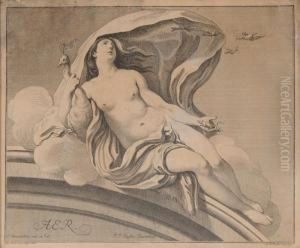Johan Martin Preisler Paintings
Johan Martin Preisler was a prominent figure in the 18th-century European art world, known for his mastery in engraving. Born in Nuremberg, Germany, in 1715, Preisler grew up in an era when the arts were flourishing under the patronage of European nobility and the burgeoning interest of the middle class. His early life is somewhat obscure, but it is evident that he was drawn to the art of engraving at a young age, likely influenced by the rich artistic traditions of his homeland.
Preisler's talents soon earned him recognition beyond the borders of Germany. He developed a distinctive style that was characterized by meticulous detail, graceful composition, and the ability to capture both the subtleties of human expressions and the grandeur of architectural settings. His works included portraits, mythological scenes, and reproductions of paintings, contributing to the dissemination of visual culture across Europe. Through his engravings, Preisler played a crucial role in making the masterpieces of contemporary and earlier artists accessible to a wider audience.
In the mid-18th century, Preisler moved to Copenhagen, Denmark, where he would become an influential figure in the Danish art scene. His arrival coincided with a period of significant cultural development in Denmark, driven in part by the enlightened absolutism of the Danish monarchy. Preisler became a central figure in this cultural milieu, contributing not only through his engravings but also by training the next generation of artists. Among his students was the renowned Danish painter Nicolai Abildgaard, indicating Preisler's impact on the development of Danish art.
Johan Martin Preisler's work earned him considerable fame during his lifetime, and his engravings continue to be appreciated for their technical skill and artistic beauty. He passed away in Copenhagen in 1794, leaving behind a legacy that bridged German and Danish art traditions and contributed to the European Enlightenment's visual culture. Through his engravings, Preisler captured the intellectual and aesthetic spirit of his time, making a lasting contribution to the history of European art.
